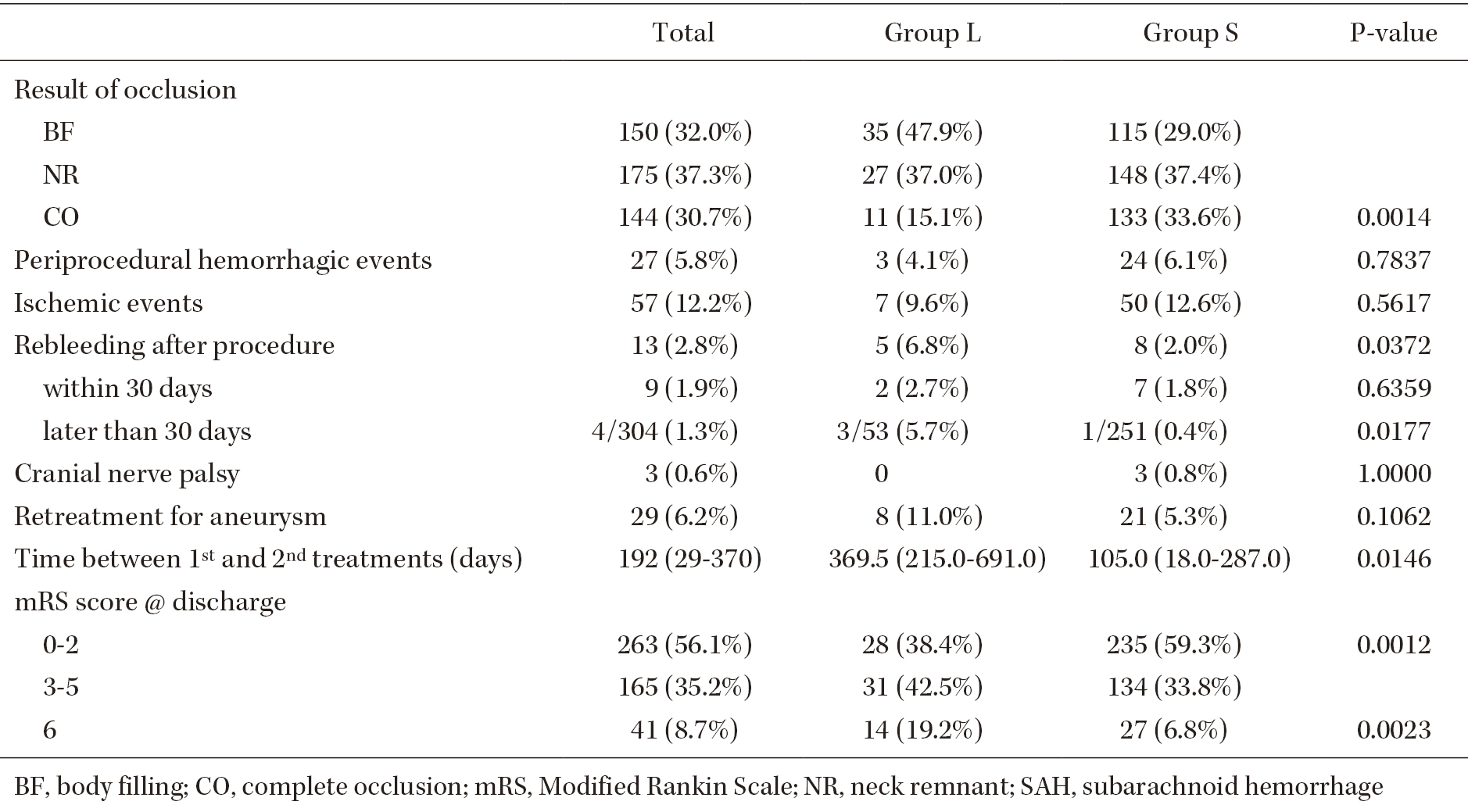- 著者
- Takao KOISO Yoji KOMATSU Daisuke WATANABE Go IKEDA Hisayuki HOSOO Masayuki SATO Yoshiro ITO Tomoji TAKIGAWA Mikito HAYAKAWA Aiki MARUSHIMA Wataro TSURUTA Noriyuki KATO Kazuya UEMURA Kensuke SUZUKI Akio HYODO Eichi ISHIKAWA Yuji MATSUMARU
- 出版者
- The Japan Neurosurgical Society
- 雑誌
- Neurologia medico-chirurgica (ISSN:04708105)
- 巻号頁・発行日
- pp.2022-0253, (Released:2023-01-05)
- 参考文献数
- 15
The influence of aneurysm size on the outcomes of endovascular management (EM) for aneurysmal subarachnoid hemorrhages (aSAH) is poorly understood. To evaluate the outcomes of EM for ruptured large cerebral aneurysms, we retrospectively analyzed the medical records of patients with aSAH that were treated with coiling between 2013 and 2020 and compared the differences in outcomes depending on aneurysm size. A total of 469 patients with aSAH were included; 73 patients had aneurysms measuring ≥10 mm in diameter (group L), and 396 had aneurysms measuring <10 mm in diameter (group S). The median age; the percentage of patients that were classified as World Federation of Neurological Surgeons grade 1, 2, or 3; and the frequency of intracerebral hemorrhages differed significantly between group L and group S (p = 0.0105, p = 0.0075, and p = 0.0458, respectively). There were no significant differences in the frequencies of periprocedural hemorrhagic or ischemic events. Conversely, rebleeding after the initial treatment was significantly more common in group L than in group S (6.8% vs. 2.0%; p = 0.0372). The frequency of a modified Rankin Scale score of 0-2 at discharge was significantly lower (p = 0.0012) and the mortality rate was significantly higher (p = 0.0023) in group L than in group S. After propensity-score matching, there were no significant differences in complications and outcomes between the two groups. Rebleeding was more common in large aneurysm cases. However, propensity-score matching indicated that the outcomes of EM for aSAH may not be affected markedly by aneurysm size.
- 著者
- Koji Hirata Yoshiro Ito Go Ikeda Kazuya Uemura Masayuki Sato Aiki Marushima Mikito Hayakawa Yuji Tomono Yuji Matsumaru Akira Matsumura
- 出版者
- The Japanese Society for Neuroendovascular Therapy
- 雑誌
- Journal of Neuroendovascular Therapy (ISSN:18824072)
- 巻号頁・発行日
- vol.15, no.12, pp.787-792, 2021 (Released:2021-12-20)
- 参考文献数
- 17
- 被引用文献数
- 2
Objective: Asymptomatic intracranial dural arteriovenous fistula (DAVF) is a rare disease that is often undiagnosed before symptom onset. The present study aimed to examine the detection rate and radiological features of asymptomatic intracranial DAVF using brain MRI data obtained from the Japanese brain check-up system.Methods: We retrospectively identified 11745 individuals who underwent brain MRI between January 2010 and December 2014. After a routine brain MRI screening, a definite diagnosis was made based on DSA. Data regarding sex, age, disease location, classification type, and treatment method were extracted from the system database and patients’ medical records.Results: Six individuals (0.05%; mean age, 61.0 ± 9.7 years) were diagnosed with definite intracranial DAVF. The intracranial DAVFs were located in the transverse sinus, confluence, and tentorial sinus in 2, 1, and 3 case(s), respectively. Cortical venous reflux was confirmed in four cases (66.7%), and none of the cases had intracranial hemorrhage or venous congestion. All cases had infratentorial lesions and two-thirds were Borden type II/III.Conclusion: The detection rate of asymptomatic intracranial DAVF was 0.05% based on the analysis of MRI data from the brain check-up system. Low-flow shunt and tiny cortical venous reflux were likely missed on MRI.
